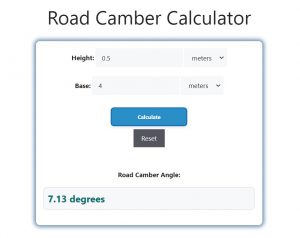About Road Camber Calculator (Formula)
A Road Camber Calculator is used to determine the camber angle, or the slope, of a road surface. Camber refers to the slight angle applied to the road’s surface, which helps with water drainage and improves vehicle safety during cornering. Road camber is particularly important for highways, racetracks, and other paved roads to enhance the driving experience and ensure proper vehicle handling. This calculator helps civil engineers, construction workers, and road designers determine the optimal camber for any road design.
Formula
The formula for calculating the road camber angle is:
A = atan(H / B)
Where:
- A is the camber angle (in radians or degrees depending on the output)
- H is the height difference between the center and the edge of the road
- B is the horizontal distance from the center of the road to the edge
- atan is the arctangent function used to calculate the angle based on the ratio of H and B.
How to Use the Road Camber Calculator
- Input the Height Difference (H): Measure the vertical difference in height between the road center and its edge.
- Input the Horizontal Distance (B): Measure the distance from the center of the road to the edge.
- Calculate the Camber Angle: The calculator will use the formula A = atan(H / B) to compute the road camber angle.
- Interpret the Result: The resulting angle can be used to adjust road construction designs to ensure optimal drainage and vehicle safety.
Example
Suppose you want to calculate the camber angle for a road where the height difference between the center and the edge is 0.5 meters, and the horizontal distance is 4 meters.
Given:
Height Difference (H) = 0.5 meters
Horizontal Distance (B) = 4 meters
Now, applying the formula:
A = atan(0.5 / 4)
A = atan(0.125)
Using a calculator, the result is approximately:
A ≈ 7.13 degrees
Therefore, the camber angle is approximately 7.13 degrees, which ensures proper water drainage and driving safety.

FAQs
- What is a Road Camber Calculator?
A Road Camber Calculator helps calculate the slope or angle of a road surface for optimal drainage and vehicle handling. - What is the formula for road camber?
The formula is A = atan(H / B), where A is the camber angle, H is the height difference, and B is the horizontal distance. - Why is road camber important?
Road camber improves water drainage, reduces the risk of hydroplaning, and enhances vehicle stability during cornering. - What does atan(H/B) represent?
The function atan(H/B) calculates the arctangent, which is used to determine the angle based on the ratio of height difference (H) to the horizontal distance (B). - What is a typical camber angle for roads?
Camber angles typically range between 2 to 4 degrees, depending on the type of road and its intended use. - Can camber be negative?
Yes, negative camber occurs when the road edges are higher than the center, often used in specific cases like racetracks. - How does camber affect vehicle handling?
Proper road camber improves tire contact with the road during cornering, enhancing grip and reducing wear on the tires. - What is the ideal camber for highway roads?
For highways, a camber angle of 2 to 3 degrees is commonly used to facilitate water drainage while maintaining smooth vehicle handling. - Is the camber angle always in degrees?
The camber angle can be expressed in degrees or radians depending on the preferences or needs of the user. - What happens if a road has no camber?
Roads without camber may accumulate water, leading to puddles and an increased risk of hydroplaning during rainfall. - How does camber improve road safety?
Camber directs water off the road and provides better vehicle control during cornering, contributing to overall road safety. - Can the camber angle be too steep?
Yes, an excessively steep camber angle can make driving uncomfortable and reduce traction on flat sections of the road. - What tools are used to measure road camber?
Camber is typically measured using a clinometer or digital angle gauge for precision during construction. - Can this calculator be used for race tracks?
Yes, race tracks often use camber for better vehicle handling during high-speed turns, and the calculator can help design the appropriate angle. - How does camber influence tire wear?
Proper camber reduces uneven tire wear by ensuring more even tire contact with the road surface, especially in corners. - What if the road has varying camber across its width?
For roads with varying camber, measurements should be taken at multiple points to calculate the overall slope for each section. - Can this calculator be used for curved roads?
Yes, this calculator can be used for both straight and curved roads by adjusting the height and horizontal distance measurements accordingly. - Does camber affect fuel efficiency?
Proper camber can slightly improve fuel efficiency by reducing drag and improving tire-road contact, leading to smoother driving. - How do you adjust camber during road construction?
Camber is adjusted by raising or lowering the road’s center or edges based on the calculated angle, ensuring proper drainage and vehicle control. - What is the maximum recommended camber angle for urban roads?
Urban roads typically use a camber angle between 1.5 to 3 degrees to balance drainage and smooth driving.
Conclusion
A Road Camber Calculator is an essential tool for designing roads that promote safe driving and effective water drainage. By using the formula A = atan(H / B), engineers and road planners can accurately calculate the camber angle needed for specific road sections. Whether you’re building a highway, race track, or city road, understanding camber is crucial to ensuring both road longevity and vehicle safety.